1970 SS396/454-Optioned Malibu
|
|
|
|
|
|
|
|
|
The 1970 model year added a second SS option, RPO Z15 for the SS454. Both the Z15 (SS454) and Z25 (SS 396) still remained an option on any V8 Malibu 2-door sport coupe, convertible, or sedan pickup body style and gone was the 1969 one year only availability of the SS 396 option on the 300 Deluxe coupe and sport coupe.

The only way to truly document a 1970 Chevelle as having the SS396 or SS454 option is with some sort of paperwork showing the option itself or the stamped engine suffix code and partial VIN matching the car's VIN. Examples would be the build sheet, warranty card Protect-O-Plate showing a 396 or 454 engine suffix, or an original factory stamped engine where the partial VIN stamping is a match to the car's VIN.
There is a bit of engine confusion for 1970. The venerable 396 received a +.030 bore to bring it to 402 cubic inches in late 1969. Chevrolet was already heavily invested in the SS 396 nameplate mystique so this slightly larger engine was still referred to as a "396." Why the 396 was bored to 402 isn't exactly known although there are plenty of thoughts on the subject. The one I would conform to is there were different emissions regulations for engines over 400 cubic inches than there were for engines under 400 cubic inches and this was an easy way out for Chevrolet without having to design a new Mark-IV engine and still have two engine sizes for SS-optioned Chevelles.
To compound the matter a bit more, a second 402 cubic inch engine was introduced under the regular production option code of RPO LS3. Essentially the same engine as the L34 available in the SS 396 but with no chrome trim (valve covers, air cleaner, etc.) and a slightly less horsepower rating of 330hp. The LS3 engine was available in any series and body style available in 1970 except an SS-optioned V8 Malibu.
If you're not already confused with the L34 vs. LS3 402 cubic inch engine, Chevrolet also introduced a 400 cubic inch small block engine (RPO LF6) for full size cars and the Monte Carlo. Chevrolet continued to call the L34/402 a "396" and they called the LS3/402 a "400-4" or "400 Turbo-Jet" while they called the small block 400 engine a "400-2" or "400 Turbo-Fire." The "-4" and "-2" referred to the carburetor for each engine and all big-block Chevrolet engines were "Turbo-Jet" while small-bock engines were "Turbo-Fire"; the LS3 got a 4-barrel while the LF6 (RPO LF6) received only a 2-barrel. The LS3 engine will become important in 1971 & 1972 as well.
The 1970 RPO Z25 SS 396 option included the L34 396/350hp engine with the L78/375hp engine available until GM cancelled the L78 engine on October 30 of 1969 with the announced release of the LS6/450hp version of the 454 engine. Part of GM's letter states, "In conjunction with the release of LS6 450-hp engine, the 375-hp Engine Option L78 and the L78/L89 for use with SS 396 is in process of being cancelled, and further orders for these options should not be submitted." The L78 engine cars already in the pipeline were allowed to proceed until L78 engine stocks at plants were depleted. If there were no more L78 engines to complete orders, those orders were returned to the dealer and customers had to make a different engine choice. See my LS6 Registry site at http://ls6registry.com/tech/trivia.htm for more details of the cancellation of the L78 engine and release of both the LS5/360hp and LS6/450hp 454 engines.
Interior
Contrary to popular belief bucket seats and/or gauges were not standard equipment. A front cloth/vinyl bench seat (except the El Camino and convertibles got all vinyl bench seat standard), no gauges (except speedometer and fuel gauge) were standard with the RPO Z25 SS 396 option and the Z25 option required either the Muncie M20/M21 4-speed manual or M40 TH400 3-speed automatic. The RPO Z15 SS454 still did not come with bucket seats or gauges but it did mandate either the optional M22 Muncie 4-speed manual or a heavy duty M40 TH400 3-speed automatic.
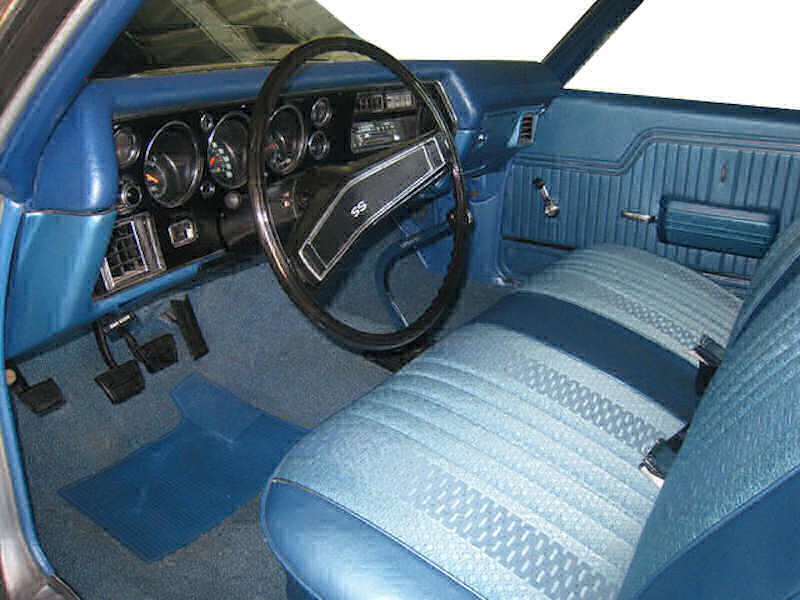
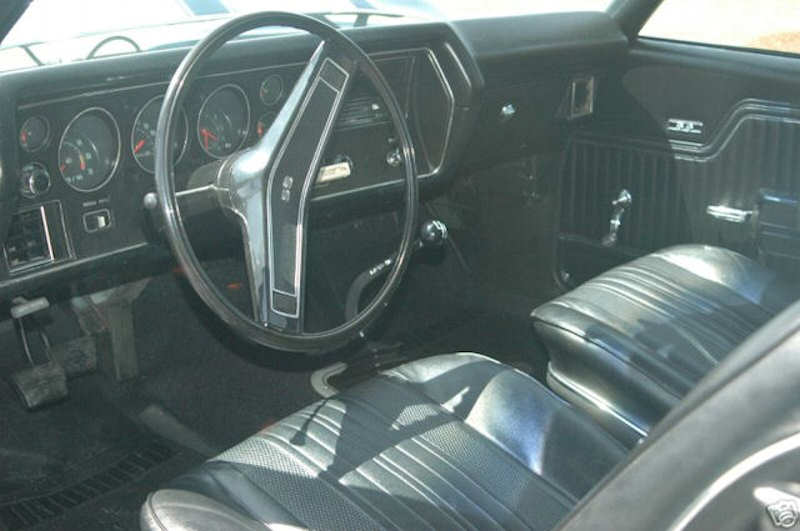

RPO A51 bucket seats did NOT mandate a center console. Although the majority of bucket seat optioned Malibus ordered a center console, it was not mandatory. There were 99,138 A51 bucket seat options sold in 1970 Chevelles but only 90,436 center consoles leaving 8,702 bucket seat optioned Malibus without a center console. The 4-speed manual transmission shifter ball is black when no console was ordered.
Dash
Both SS options also included a different dash than their non-SS counterparts. Round gauge pods housing the fuel gauge and speedometer replaced the sweep design of non-SS Chevelles. Any V8 Malibu coupe, convertible, or El Camino could order RPO U14 Instrument Panel gauges and get the same round gauge pod dash and it would include a tachometer, (moved) fuel gauge, speedometer, amp, and water temperature gauges. So, a base SS-optioned Malibu would have the round gauge pods but no tachometer, no amp and no water temperature gauges unless RPO U14 was ordered in which case it got the same gauges with the exception of the redline on the tachometer.

Base Chevelle/Malibu dash with 'sweep' speedometer.
SS Steering Wheel
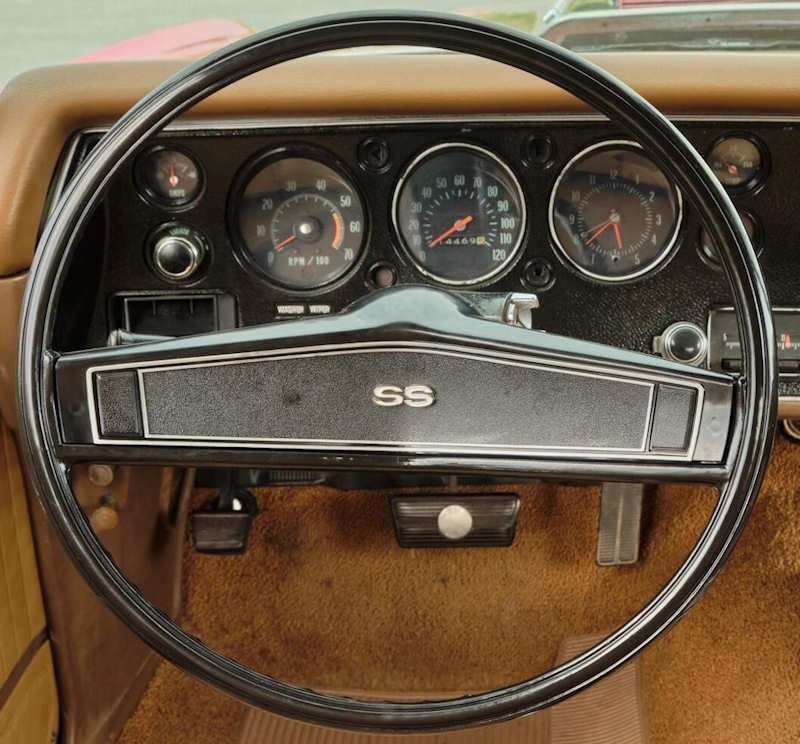
Like the 1969 model year with the SS 396 option, both the SS 396 and
SS 454 received the same base steering wheel. And, like 1969, all SS
396 and SS 454 steering wheels were black regardless of the interior
color. If you put your computer mouse over the image you will see the
1969 version of the SS steering wheel.
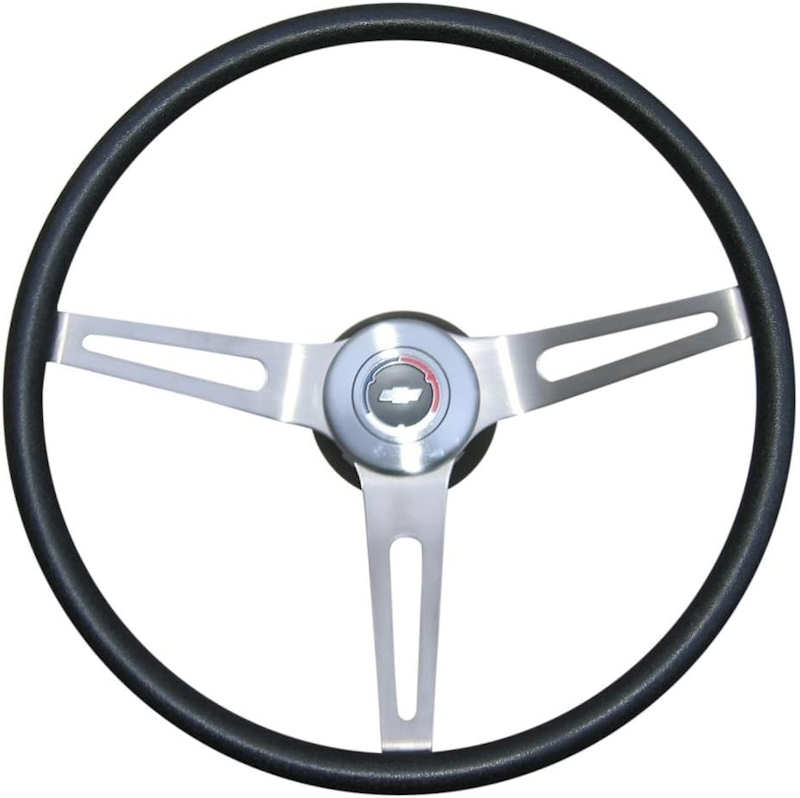
The faux wood-grained steering wheel that had been an option since 1966
was gone and replaced in 1970 by a 'cushioned rim' unit. An optional
steering wheel in any 1970 Chevelle, SS-optioned or not. Only 3,078
were optioned in 1970, about 0.5% of all 1970 Chevelles sold.
SS396 and SS454 Instrumentation
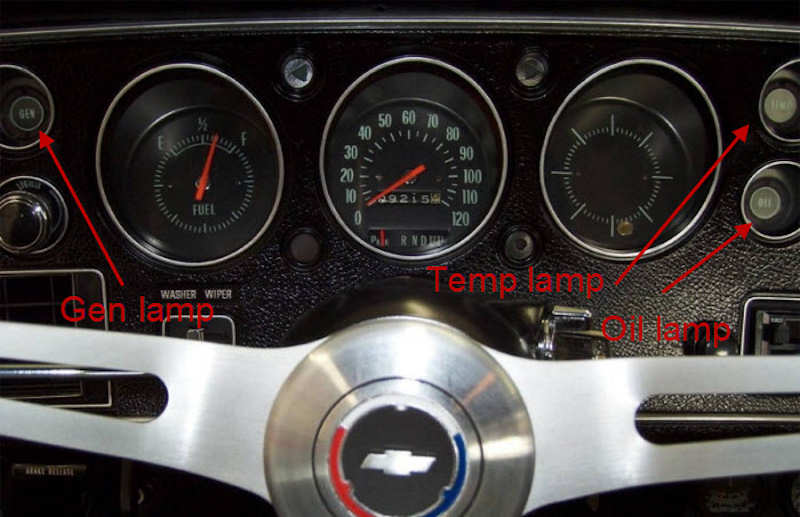
The base SS (396 or 454) dash with round gauge pods for fuel and speedometer.
Note warning lamps for GEN (upper left), TEMP (upper right) and OIL
(lower right).

Another base SS dash with optional clock, no tach or gauges.
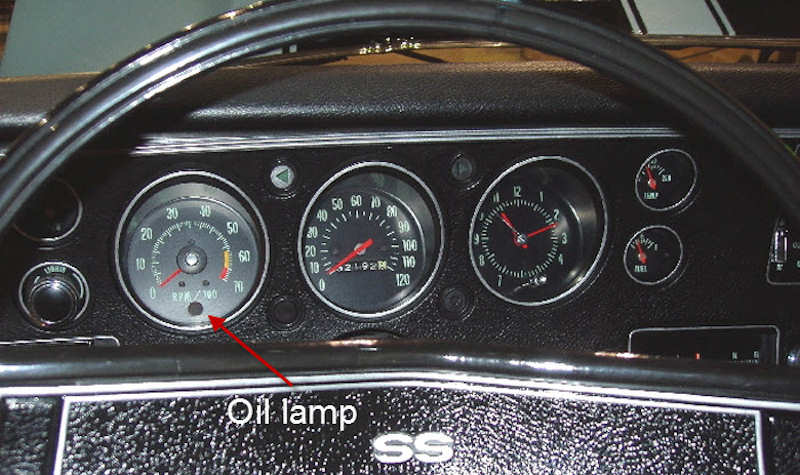
An
SS or Malibu dash with optional RPO U14 Instrument Panel gauges. Not
visible is the amp gauge that has been moved to the upper left opening
replacing the GEN lamp. The TEMP gauge replaces the TEMP lamp in the
upper right opening and the fuel gauge is located in the old OIL lamp
opening. The oil warning lamp is now moved to the lower center of the
tachometer. This dash is from an LS6 as noted by the redline on the
tachometer although an L78-optioned Chevelle will have the same redline
tachometer when gauges are ordered.
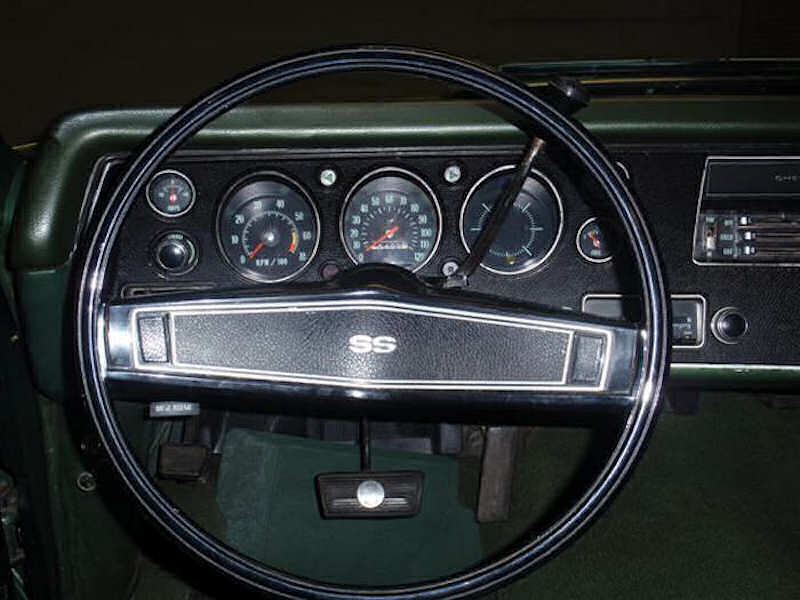
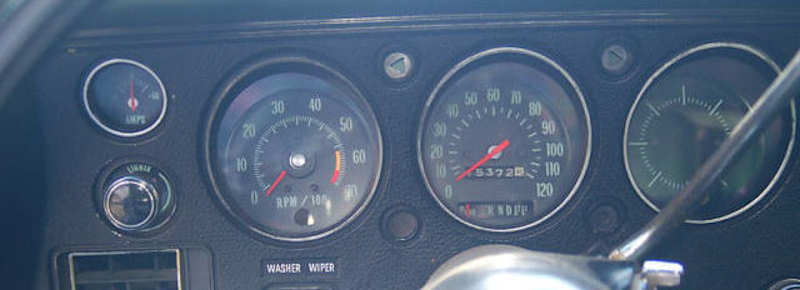
These examples show the AMPS gauge location but note there is no clock
which is reported in GM documentation to be part of RPO U14 Instrument
Panel gauge option. It's unknown why numerous Chevelles have been found
with the U14 option but no clock. Note: The bottom image is an
owner-modified dash. The owner added the tach and gauges to a
non-gauge dash is did not include the electric clock in the large
right-most pod. The electric clock (while an option by itself) was
part of RPO U14 Special Instrumentation.
Prior to 02-10 Baltimore did not show U35 on their build sheet when U14 was ordered but all Baltimore build sheets from 02-10 to the end of production do. Same with Kansas City but the date of change is different, 10-06. All other plants showing RPO U14 also show RPO U35. Both of the photos above are from Kansas City L78 Chevelles so they are obviously early model year.
The tachometer redline might also give you some indication of which
engine was installed. All 3 have the same range, 0-7000, but the redline
differs depending on engine (and plant it has been discovered).
See Tachometer Broadcast Codes.
1. The 307 and two 350 engines tachometers redline at 5000 RPM (broadcast
code 938).
2. The 402/330 (LS3), 396/350 (L34) and 454/360 (LS5) engines tachometers
redline at 5500 RPM(1) with broadcast code 985.
3. The high performance 396 (L78) and 454 (LS6) redline at 6500 RPM.
(broadcast code 983)
(1) To date, all documentation shows that the Atlanta plant
installed the 5000 RPM redline tach in all base SS454 Chevelles through
at least late April or early May. It is assumed this was a computer
programming error that generated the code for the 5000 RPM tachometer
instead of the 5500 RPM unit. This appears to have been 'fixed' by at
least 05-05.

5000 RPM redline tachometer found in an 05A body dated Atlanta LS5 sport
coupe although the car has no supporting documentation.
The code for the 3 different tachometers can be found in block #72 of the build sheet; 938 for the 5000 RPM redline, 985 for the 5500 RPM redline, and 983 for the 6500 RPM redline.
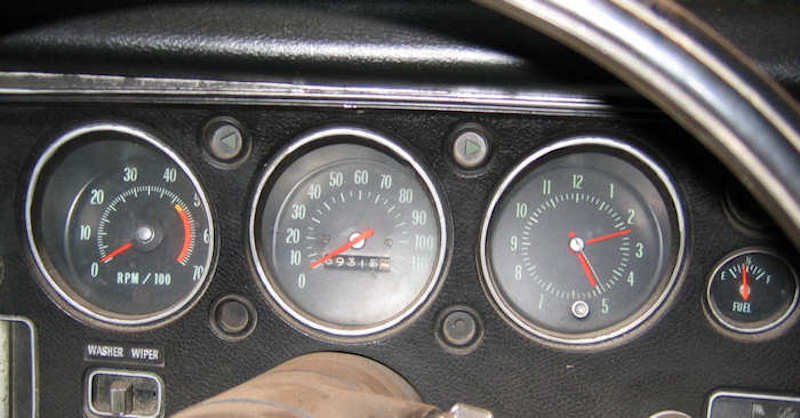
Here is a documented Atlanta LS5 Chevelle with a build sheet schedule
date of 1-25 with a 5000 redline tachometer.
Note the oil warning lamp in the tachometer face in lieu of an oil pressure
gauge.
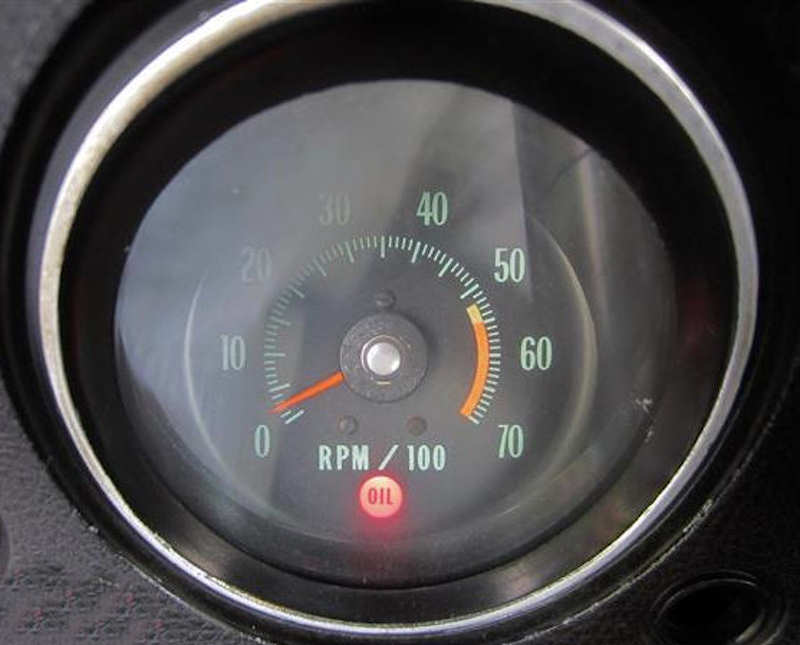
Original tachometers used three screws to mount the face. Note in the above examples the centered screw just above the needle center point and two lower screws above RPM and 100. An aftermarket tachometer has two mounting screws at "10" and "60" RPM numbers.
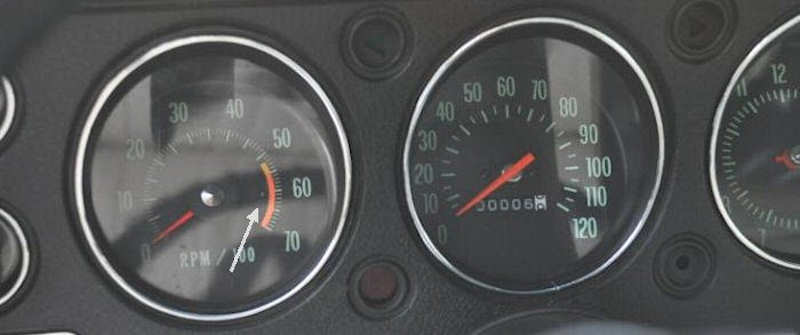
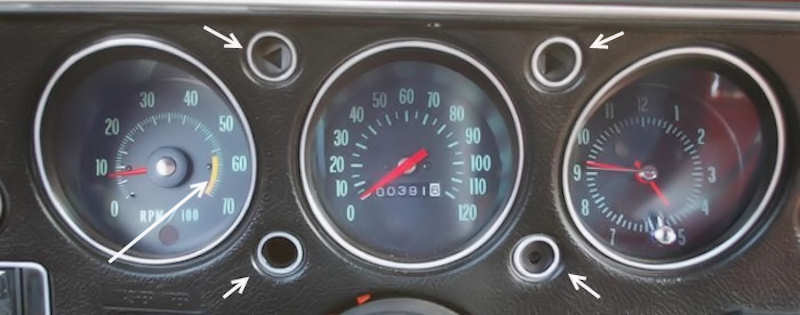

Note the silver outlining of the four smaller circle pods for turn indicators,
brake, and high beam warning lamps on the two dash faces below. These
are either added by the owner or found on aftermarket replacement dash
faces and not something original dash faces had indicating a dash change
or dressing up by a previous owner.
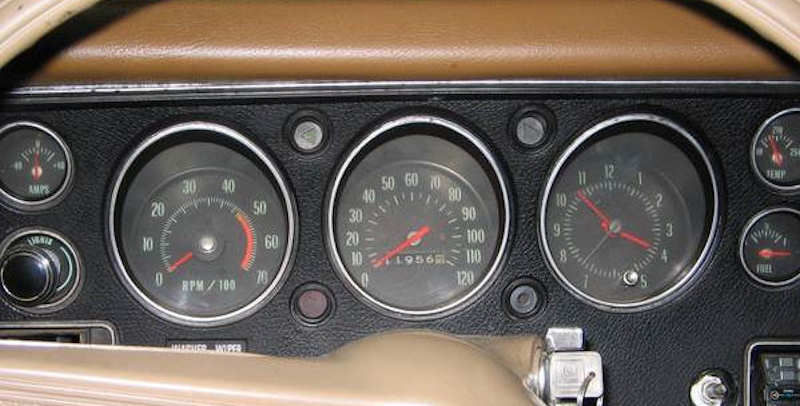
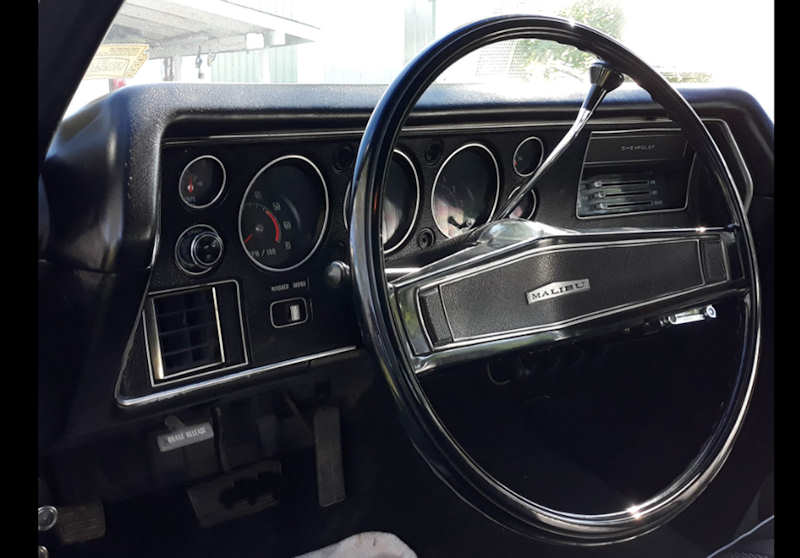
This is the U14 I/P Gauge option in a 307cid/350cid non-SS Malibu Contrary
to popular belief the gauge option was available in non-SS optioned
V8 Chevelle sport coupes, convertibles, and sedan pickups as well.
The Monte Carlo dash is often installed in Chevelles with a claim something like, "...the factory ran out of Chevelle dash assemblies and substituted the Monte Carlo dash to keep the line moving." To date I've not seen one documented case of this happening. Sub assemblies such as a dash assembly would be on hand before the particular car was scheduled to be built; running out of a dash assembly seems highly unlikely. In any event, the Monte Carlo dash is easy to spot with its wood-grain appliqué. All Monte Carlos got the round face dash. The base dash included the fuel gauge, speedometer and clock.
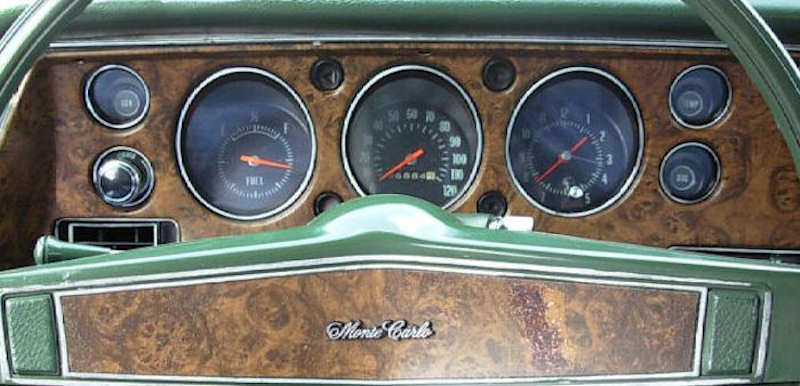
When RPO U14 Instrument Panel Gauges were ordered in a Monte Carlo they were placed in the same location as the gauge package would be on a Chevelle.
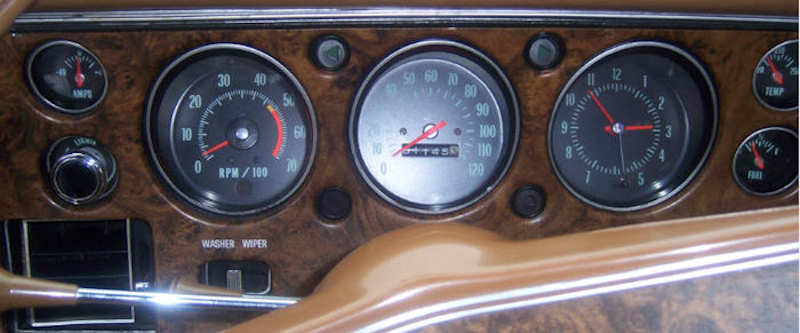
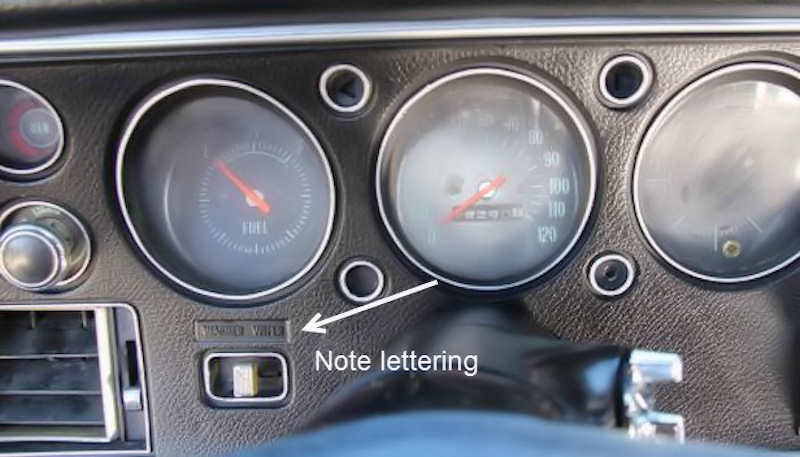
While there's nothing really wrong with a reproduction dah as originals
are often damaged but you might want to be aware of some things to look
for. In the example here, note the lettering on the WASHER WIPER.
The letters have a very small height (from the dash outward) but are
not white. The lettering on LIGHTER is the same way.
Miscellaneous SS Information
The RPO Z25 SS 396 option included the 350hp, Turbo-Jet 396 V8, dual exhaust, special domed hood, black-accented grille, power disc brakes, sport wheels, wide-oval white lettered tires, wheel opening moldings, black resilient rear bumper panel, bright engine accents, and special chassis features. The SS 396 option added $445.55 to the base price of the Malibu. Also required with the SS 396 option was either the Muncie M20/M21 4-speed transmission at $184.80 or the M40 TH400 3-speed automatic at $221.80; in total the SS 396 option added $630.35 ($445.55+$184.80) or $667.35 ($445.55+$221.80).
The RPO Z15 SS454 option included the same basic equipment as the RPO Z25 SS 396 option with the primary exception of the engine where the 350hp 396 was replaced with the 360hp 454. The SS454 option added $503.45 to the base price of the V8 Malibu. Also required with the SS454 option was either the Muncie M22 4-speed transmission at $221.80 or the M40 TH400 3-speed automatic at $221.80; in total the SS454 option added $725.25 ($503.45+$221.80).
All SS 396- and SS454-optioned Chevelles came with a 12-bolt rear end but Positraction was still an option; an open rear end was standard. However, a 12-bolt rear end, as well as Positraction, was available on non-SS 396- and non-SS454-optioned Chevelles as well so the presence of a 12-bolt (with or without Positraction) is not an indication of a 1970 SS 396- or SS454-optioned Chevelle. There are some rear end stamped ratio codes that are unique to the SS454-optioned Chevelles such as CRU, CRV, and CRW. Rear end codes for the 396 (402) are not SS 396-specific though as those were also used with LS3 and L48 engines as well. See the rear axle code section of 1970 for more.
Both the SS 396 and SS454 got the same SS grille emblem but the front fender emblems did distinguish between "SS 396" and "SS 454" and the Custom El Camino also sported "SS 396" or "SS 454" on the tailgate as appropriate. The sport coupe and convertible had an "SS" logo on the rear bumper pad. A bi-product of the rear bumper pad was no rear bumper guards were possible on either SS option due to the pad.
Several rear end ratios were available on SS-optioned Chevelles and a couple of those were also available as options with non-SS L48 350cid Chevelles. Data is taken from build sheets and/or warranty card Protect-O-Plates.
What Did The SS Options Add or Take Away?
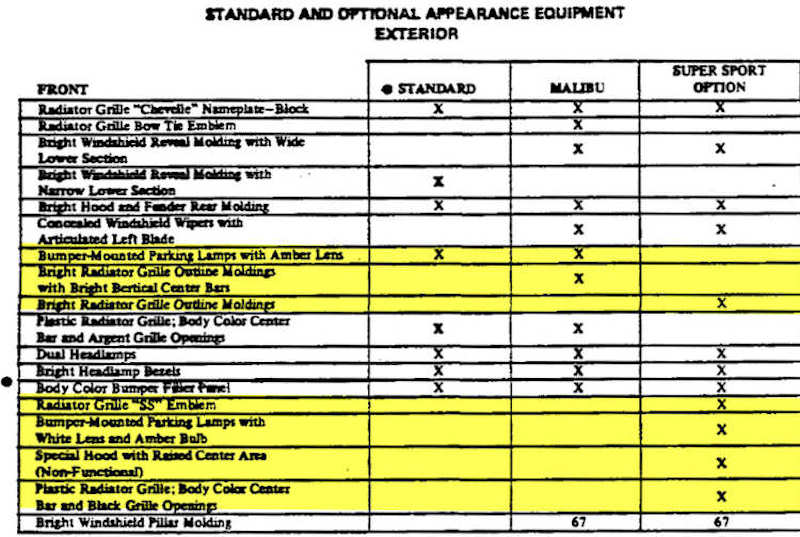
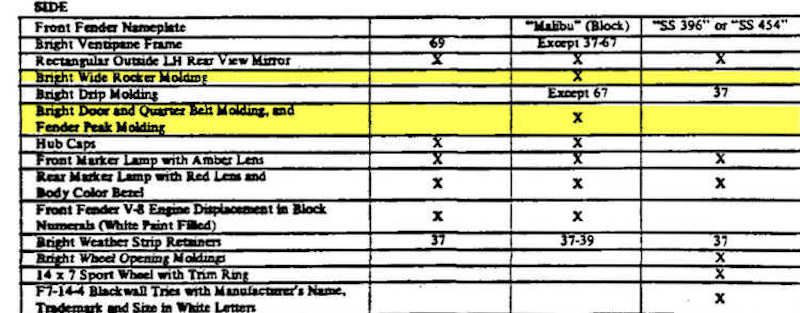
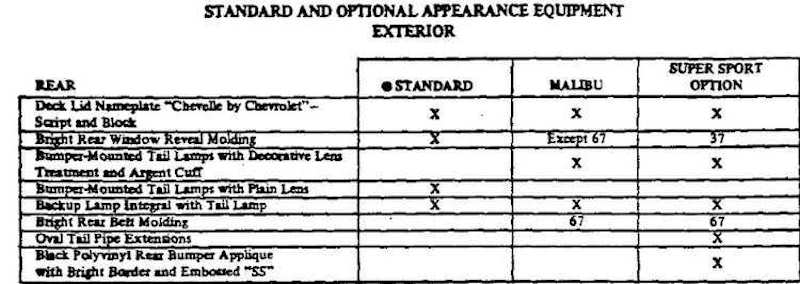
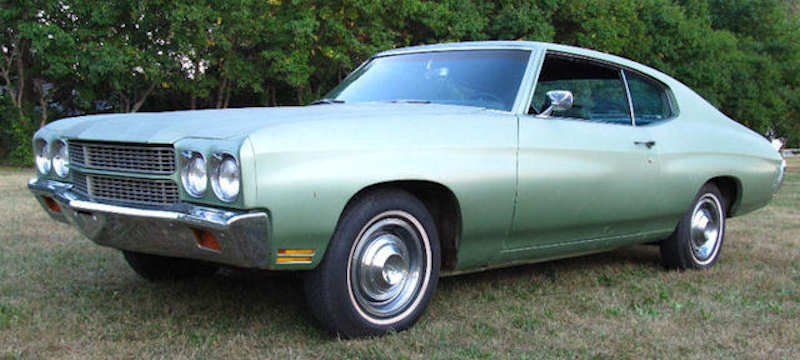
The base Chevelle Standard (13437) is almost devoid of external brightwork.
No bright rocker molding, no door and quarter bolt molding, no roof
drip rail molding - pretty much a basic car.
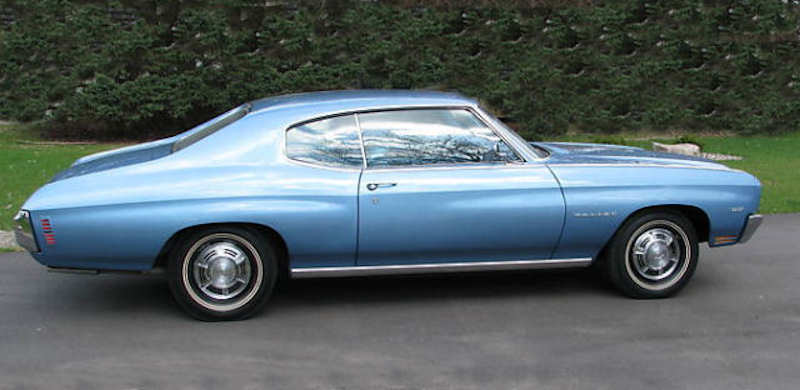
The non-SS optioned Malibu has bright lower rocker moldings. Often early
owners and even dealers would install these to 'dress up' their SS 396/SS454.
No SS 396/SS454 optioned Malibu has ever been documented as coming from
any final assembly plant with these moldings.
| Prefix | Axle Ratio |
| CCF | 3.31:1 ~ 12-bolt Positraction (L34/402 & L48/350-4) |
| CCO | 2.56:1 ~ Positraction (El Camino L34/396) |
| CCW | 3.31:1 ~ 12-bolt (L34/402 & LS3/402 M.C.) |
| CKD | 2.73:1 ~ 12-bolt (L48/350-4 & LS3/402) |
| CKF | 3.55:1 ~ 12-bolt Positraction (L78) |
| CKJ | 3.55:1 ~ 12-bolt (L78/402) |
| CKK | 4.10:1 ~ 12-bolt Positraction (L78/402) |
| CRK | 2.56:1 ~ 12-bolt Positraction (Monte Carlo LS5/454) |
| CRU | 3.31:1 ~ 12-bolt (LS5/454 & LS6/454) |
| CRV | 3.31:1 ~ 12-bolt Positraction (LS5/454 & LS6/454) |
| CRW | 4.10:1 ~ 12-bolt Heavy Duty (LS6/454) |
All rear end applications have been verified with legitimate build sheets.
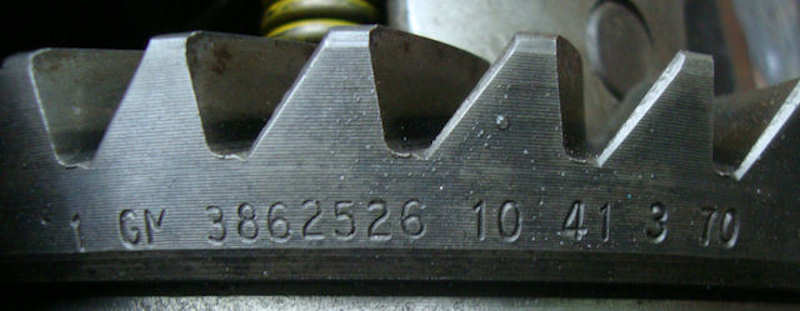
Positraction 4.10:1 ring gear.
Hood & Deck Stripes
RPO D88 Hood & Deck Stripes. Some misconception with this option. RPO D88 was available on any I6 or V8 Malibu coupe, convertible, or El Camino whether either SS option was ordered or not. To refer to a standard SS 396 or SS454 optioned Malibu as "stripe delete" is incorrect - just as it'd be incorrect to refer to any Chevelle without power steering as "power steering delete." RPO D88 was an option, therefore it couldn't be "deleted" if it wasn't ordered or part of another option package. When the D88 option (or ZL2) was ordered on the Custom El Camino, stripes were only applied to the hood. Stripe color was dependent on the color of the top, not the interior color. See the Stripe Colors page for more details.
ZL2 Special Ducted Hood Air System (a.k.a.,Cowl Induction Hood)
This brings us to RPO ZL2, the cowl induction hood option. D88 Hood & Deck Stripes were part of this option package. Therefore the stripes could be deleted on request, and often times were. The second part of the ZL2 cowl induction hood package were the hood pins. Contrary to other reports, hood pins were only standard with the ZL2 option package; hood pins did not come standard on the SS domed hoods and did not carry a separate RPO number that would make them available to other 1970 Chevelles. They could easily be purchased over the counter from Chevrolet or in the aftermarket and added by the owner. I went to a Chevrolet dealer in the early 70s and purchased a pair to install on my 1967 SS 396 rather than buy some aftermarket kits.
As mentioned before, one of the items in both SS options was a domed hood. Some refer to this hood as a non-functional cowl hood but I disagree, it is a functional hood - it performs its function - and it's not a cowl induction hood. I'm sure what people refer to as 'non-functional' is in comparison to the optional RPO ZL2 cowl induction hood.
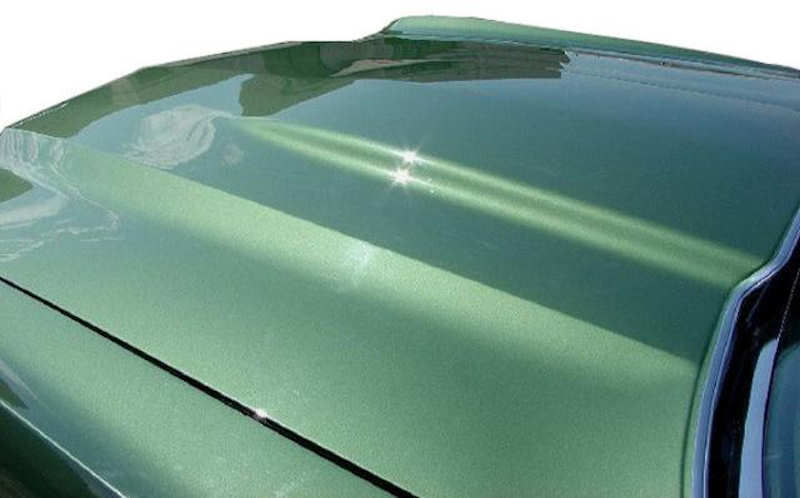
This is the domed hood the came standard on both SS 396 and SS454 Chevelles.
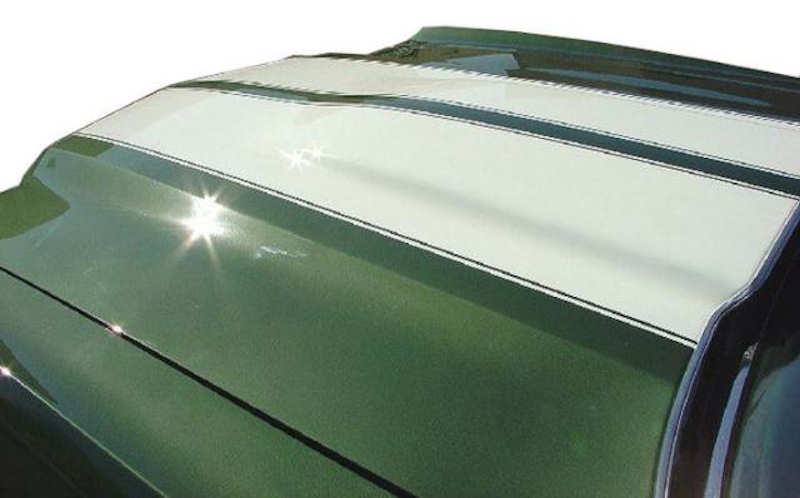
This is the same domed hood when RPO D88 Hood & Deck stripes were
ordered. Yes, the stripes were an option on both SS 396 and SS454 Chevelles.
Since this is not the ZL2 Cowl Induction hood, these stripes were optional,
there is no such thing as 'stripe delete' on a standard,
SS 396 or SS454 domed hood.
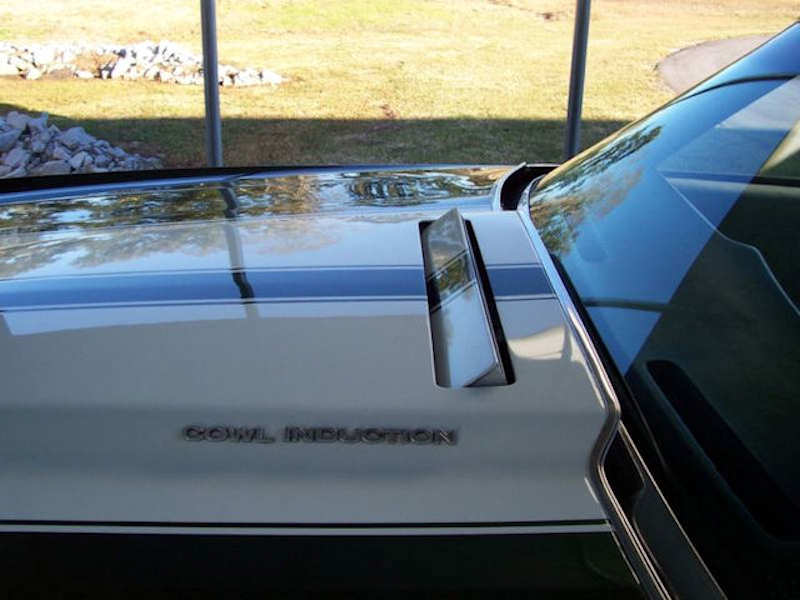
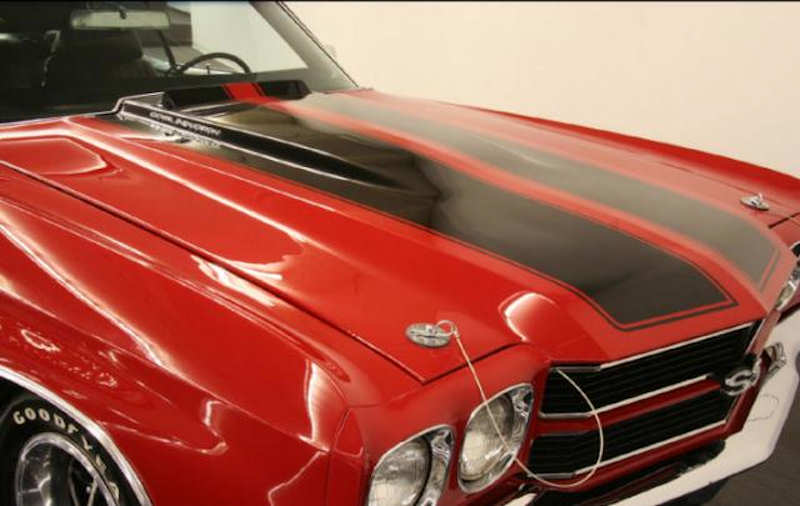
When RPO ZL2 was checked the standard domed hood was replaced with a
cowl induction hood that has a vacuum controlled 'flapper' that would
open when the engine was under throttle. Part of the ZL2 option was
the D88 Hood & Deck stripes. These could be deleted
when ordering the ZL2 at the buyer's request, unlike the mistaken notion
they could be deleted from the special domed hood when they were an
option on the domed hood (and the standard Malibu hood
as well).
F41 Suspension
Both SS options came standard with RPO F41 Special Performance Front & Rear Suspension consisting of H.D. springs with matching shock absorbers, boxed rear lower control arms, a larger front sway bar (1" vs. 1.25"), and a rear sway bar. This was only standard on the Malibu sport coupe and convertible, the El Camino did not get RPO F41 and could not order it.
Hard to see in the photo but the boxed rear lower control arm has an additional plate welded to the bottom of the (normally) U-shaped control arm.
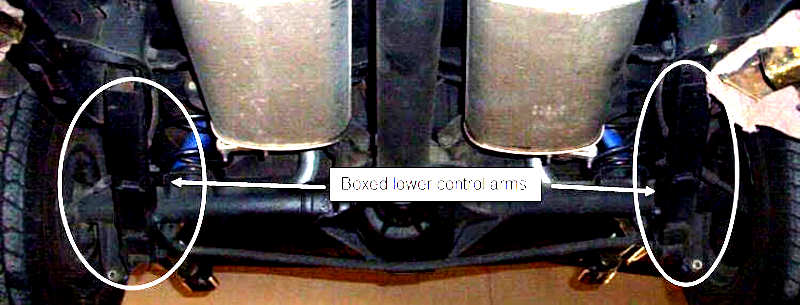
Miscellaneous
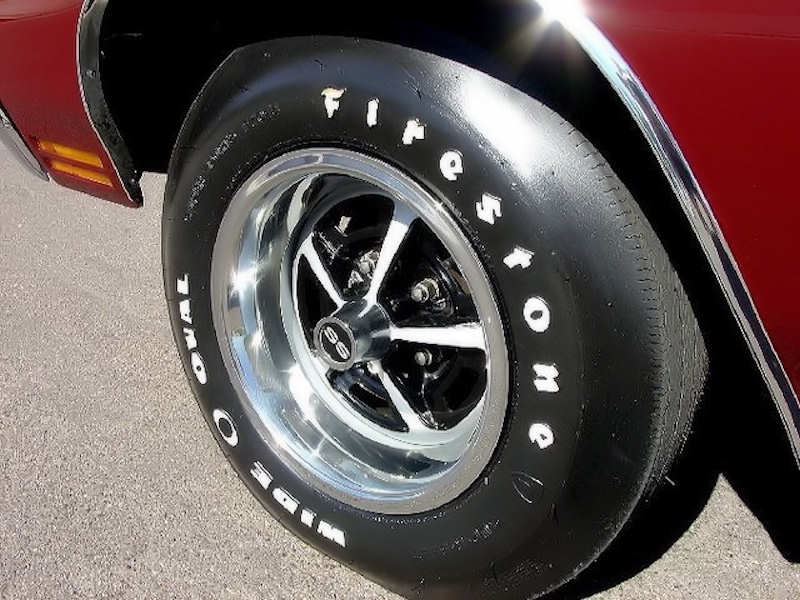
The special SS wheels were essentially the same as the 1969 SS 396 wheels
and carried no RPO number as they were exclusive to the two SS options
and part of those options.
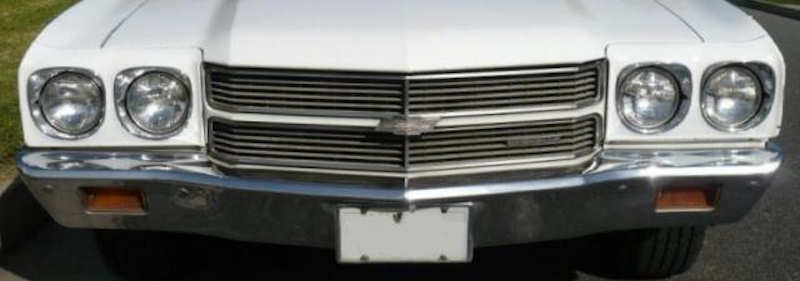
The Malibu sport coupe and convertible grille shows the brightwork as
well as a bow tie emblem along with amber color parking lamp lenses
with clear bulbs.
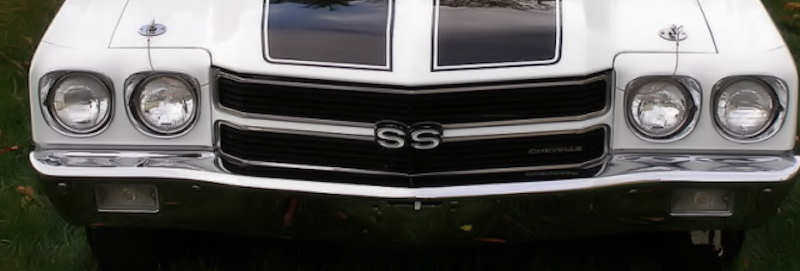
The Malibu sport coupe and convertible "SS" grille sported
blacked-out bars with "SS" emblem (regardless of engine size)
and clear parking lamp lenses with amber bulbs.
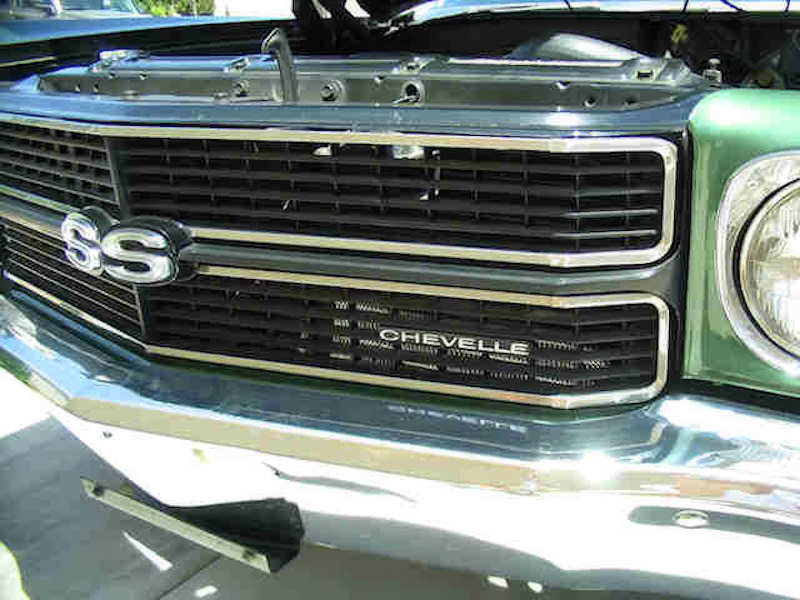
Oshawa, Ontario Canada-built 1970 SS optioned Malibus have the grille
surround molding painted a semi-gloss black instead of body color like
U.S-built 1970 SS optioned Malibus. ~ Courtesy Rick Peters

Another Canadian SS optioned Malibu, this time in Fathom Blue. Also
note bright trim under the headlamps indicating an early Chevelle. -
Courtesy Jack Aaparicio
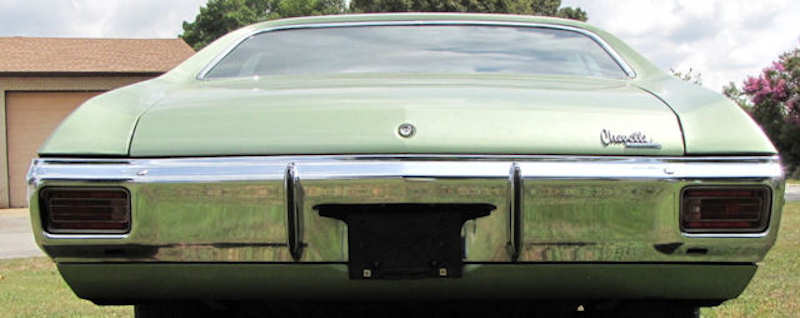
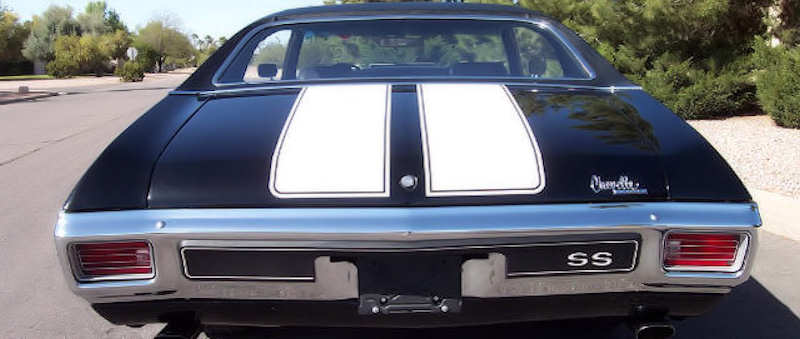
A bit of trivia...neither 1970 SS Equipment package would be ordered
with rear bumper guards (RPO V32) due to the SS pad on the rear bumper.
It's a commonly held belief that all SS optioned Malibus from the Kansas City plant have the letter "L" under the lower body paint code. While I must admit this has been the case on over 99% of 1969 and 1970 Kansas City-built, SS-optioned Malibus, there is no documentation or mention of this as being fact that has ever turned up, at least in the circles I am around. Here is a perfect example of a 1970 SS454 optioned Malibu convertible from Kansas City without this infamous letter along with a relevant portion of the build sheet.
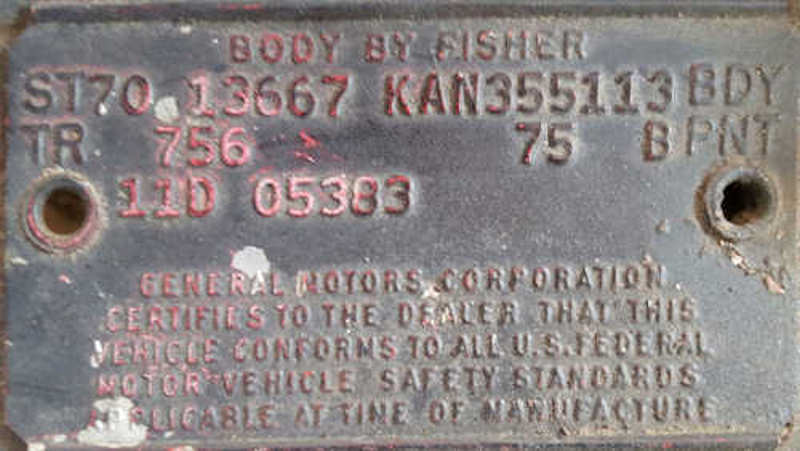

Note the highlighted numbers/letters indicating this trim tag goes with this car.
More on Stripes
Plants often varied on the style of D88 hood and deck stripes. There was a factory change that affected the distance between the wide and narrow portions of the package as well as the overall width. Additionally many plants are discovered to have applied the stripes with squared outside corners as opposed to the more common rounded corners. It is not known if this was a time-related change, a plant SOP change, or simply the way the particular painter masked the stripes. Maybe he was new in the area where stripes were painted and did not know or did not want to take the time to make the rounded corners. It makes sense that the type of stripe (square corner vs. rounded corner) would be initiated at the Fisher Body side of the plant and the Chevrolet side would have to follow suit. To date, no Chevelle has turned up with known rear square stripes and front round stripes. The Factory Assembly Instruction manual for 1970 Chevelles actually show three different versions, the initially planned version, a second version redrawn on June 4, 1969, and a third version redrawn on April 24, 1970. Note the initial version also lists series 13427 and 13437. The 13427 series/body style was never produced in the U.S. and the 13437 would wind up not being offered the option. Clearly Chevrolet was initially planning with the 1969 model year in mind and note the stripes have squared outer corners. These squared outer corners would be found in early Chevelles and even carried into the change. Just why the April 24, 1970 version indicates "(SS ONLY)" isn't known as nothing has been found to date of the D88 option being dropped from non-SS Malibus unless, for some reason, the SS-optioned Malibus got different measurements. See the RPO D88 Stripe page for more.
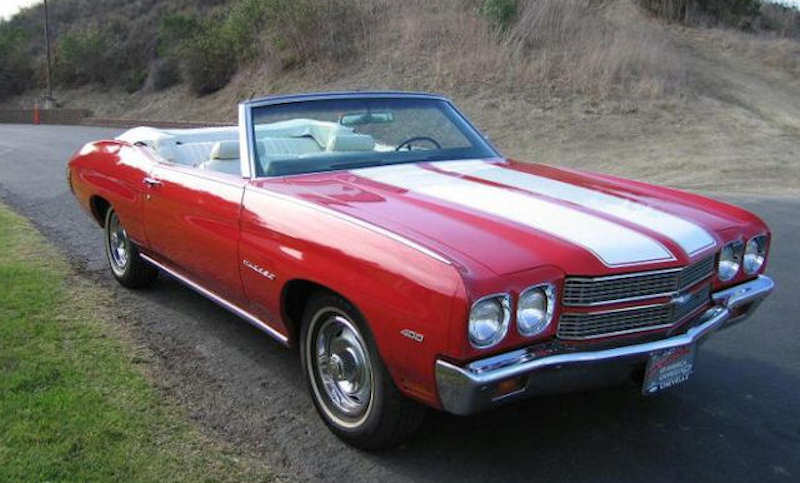
Stripes could be ordered with any Malibu sport coupe, convertible, or
sedan pickup without either SS option like this Malibu convertible.
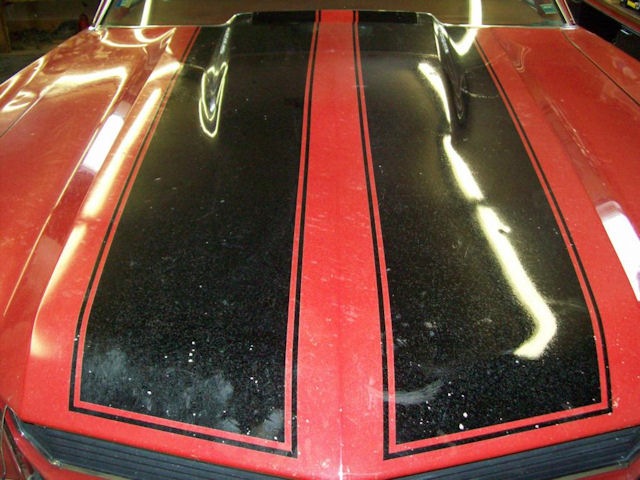
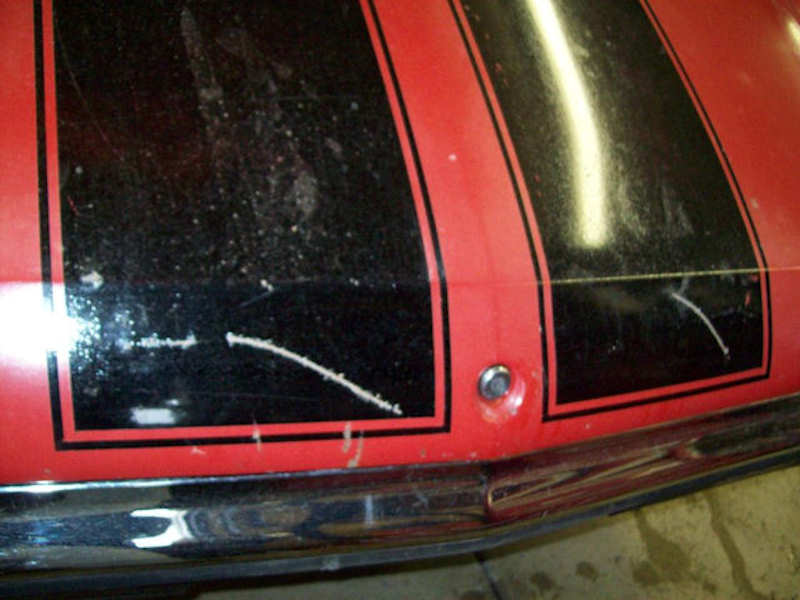
These square stripes were found on an untouched Kansas City Chevelle
dated 11D.
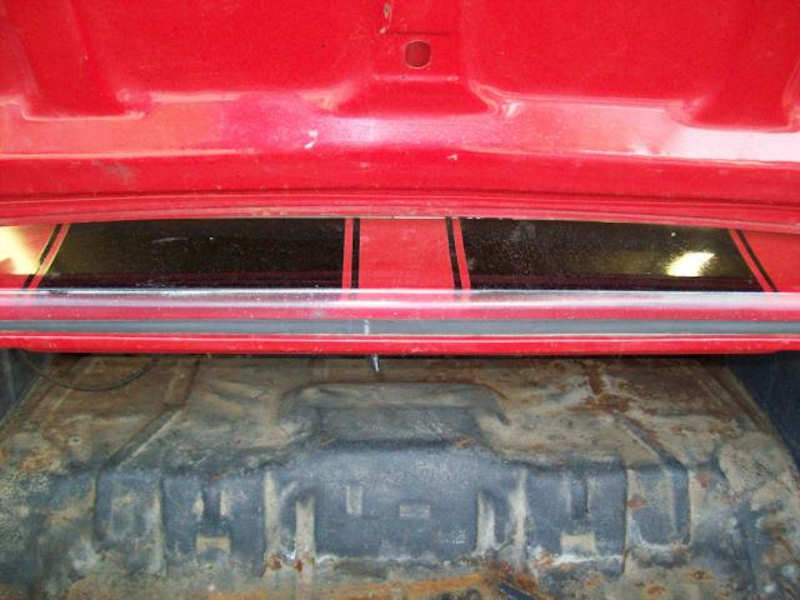
Note too the coverage of the stripes into the trunk area was not that
deep and could vary from car to car.
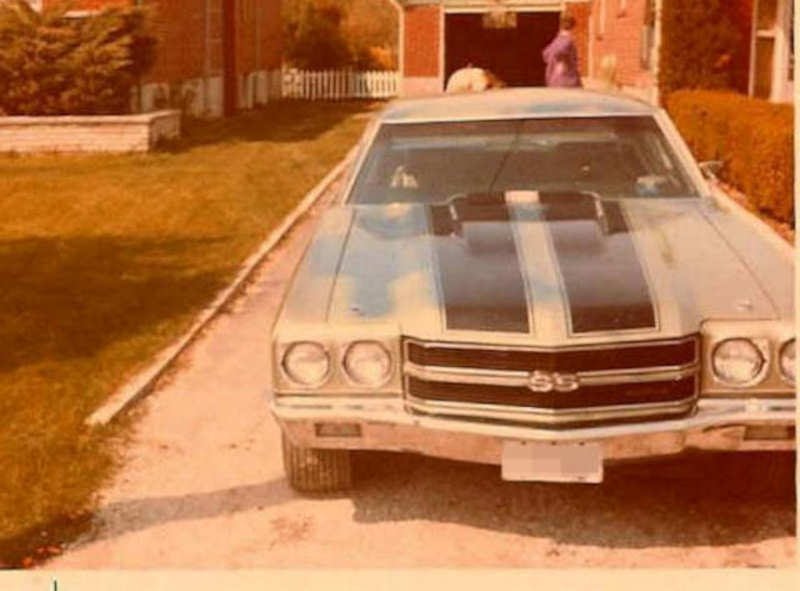
Early November Chevelle - Courtesy Danny Tarquini
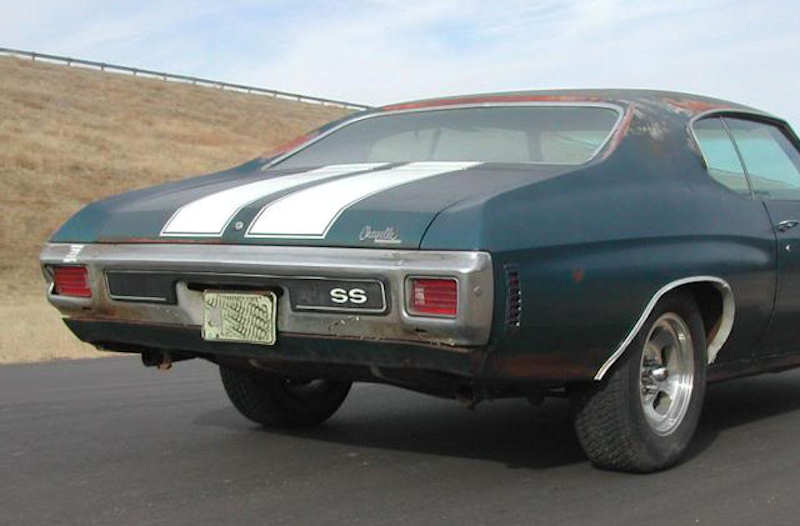
Early November Kansas City Chevelle.
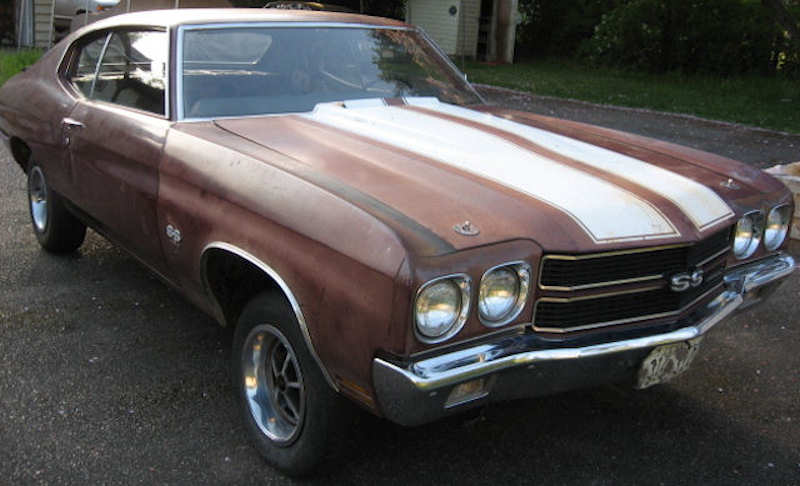
A Kansas City Chevelle dated 12C.


Arlington mid June (sequence 261445).
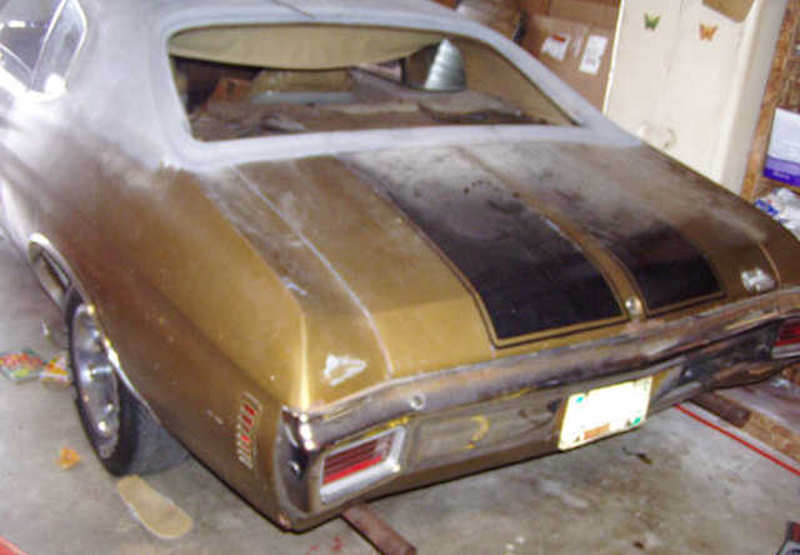
Unknown plant or time frame.
SS optioned El Caminos only received the hood stripes since they have no trunk lid.
Suspension

All SS 396 and SS454 Chevelle sport coupes and convertibles received
RPO F41 Special Suspension. This consisted of special spring and shock
rates, heavier front sway bar, boxed rear lower control arms, and rear
sway bar. RPO F41 was also available as an option on any 1970 13400,
600 - 37, 39, 67, 69 series/body style Chevelle.
The SS 396 and SS454 El Camino did not come with RPO F41 or was it available on the El Camino due to the standard factory rear air shocks on the El Camino. Rather, RPO F40, which consisted of special front springs and 2700-lb capacity rear springs was available on any 1970 Chevelle regardless of series or body style.
El Camino Specific
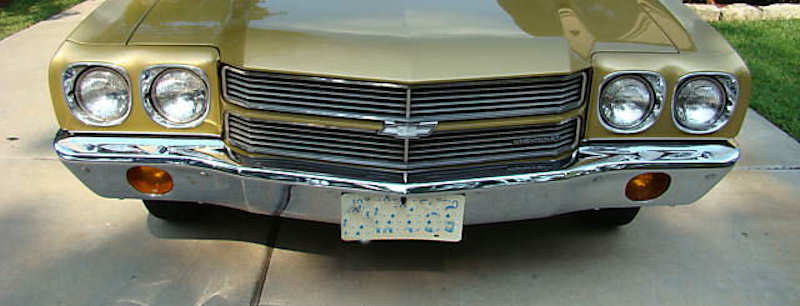
The Standard (134xx) and Malibu series El Camino has amber lenses with
clear bulbs.
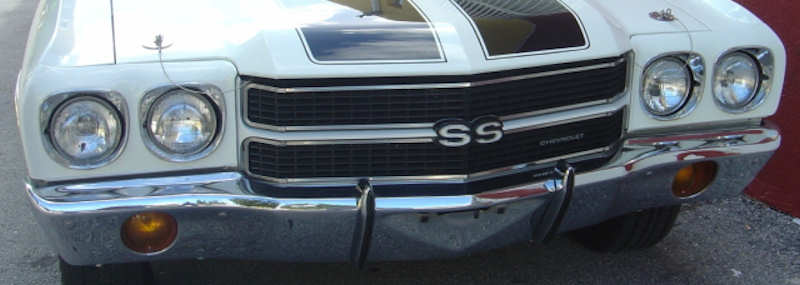
The El Camino differentiates from the Malibu sport coupe/convertible
in two ways here; the parking lamp lenses are round instead of rectangular
and the parking lamp lenses are amber regardless of whether the El Camino
is SS Equipment optioned or not.

This El Camino SS has clear lenses from the Monte Carlo and an incorrect
grille. Note bright center vertical bar and missing CHEVROLET nameplate.
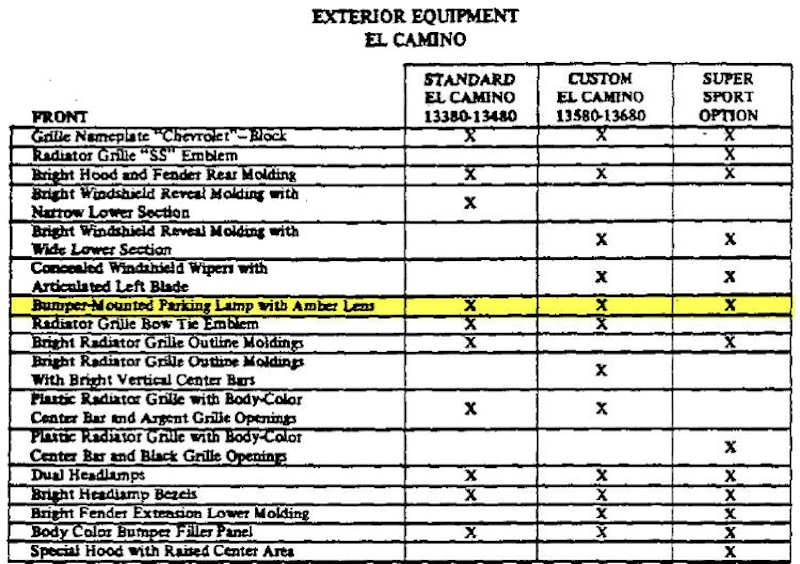
This is from Chevrolet's El Camino 'Information Kit' .PDF file and shows
all El Caminos came with amber lenses.
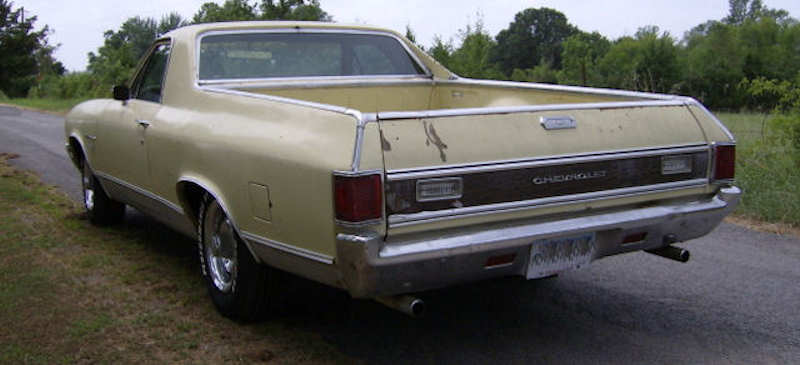
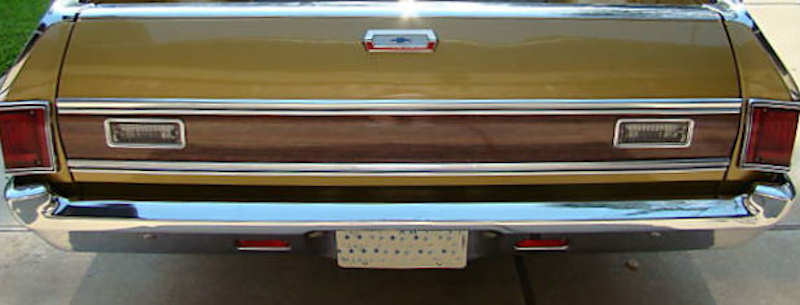
The tailgate of the non SS-optioned Custom El Camino has wood-grain
treatment inside the black paint filled horizontal moldings. Missing
from the tailgate in the lower photo above is the nameplate "C_H_E_V_R_O_L_E_T"
centered between the tail lamps.
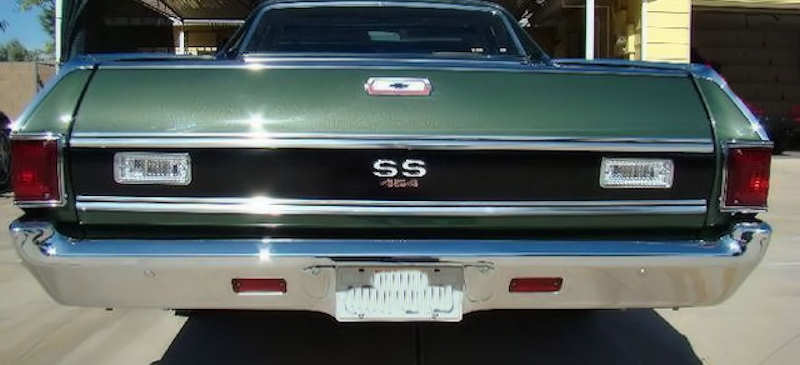
The SS-optioned El Camino has this same area done in black paint instead
of the wood-grain appliqué and either SS 396 or SS454 badging as appropriate
although several documented SS454 owners state the 454 emblem was not
installed on their car.
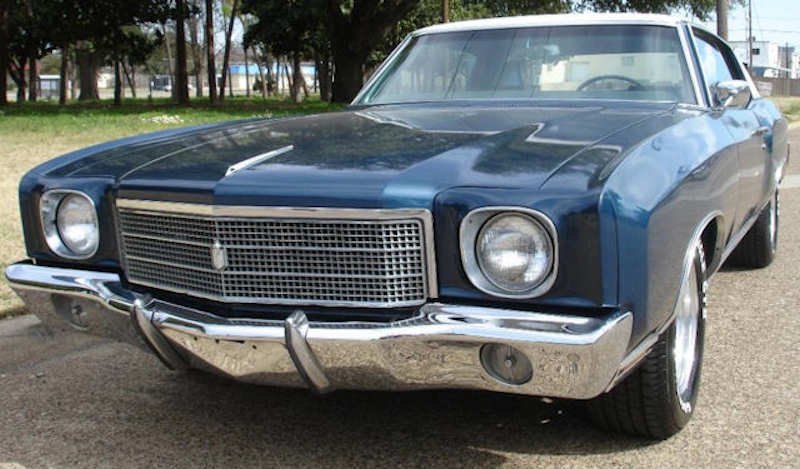
The 1970 Monte Carlo was equipped with round clear lens parking lamps.
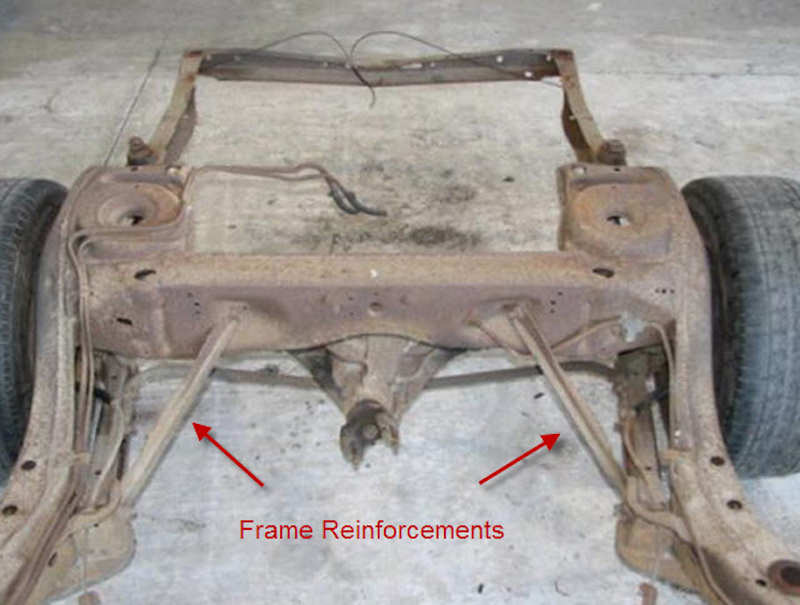
Build Sheets
Legitimate build sheets are the definitive proof of an SS optioned 1970 Chevelle showing one of the two SS options. Along with one of the two options, the vehicle's sequence number should also be in the upper right hand corner to confirm the build sheet found belongs to the car in question.
If the sequence number is missing from the build sheet but information in blocks 8 and 24 are still present, it is still possible to match the build sheet to a Chevelle. in these blocks will vary from plant to plant and just what data are present on the build sheet and the numbers on some plant's trim tags.
Take this Kansas City trim tag and matching build sheet for example. The sequence number from the build sheet is missing but the data processing numbers and/or body numbers match between the two. The 'proof' lies in the engine broadcast code in block #27 in this example. TX is the engine broadcast code and since TX is the broadcast code for a 396/350 with manual transmission and the 396/350 engine could only be had with the SS 396 option (RPO Z25), this car is a true SS optioned Chevelle.
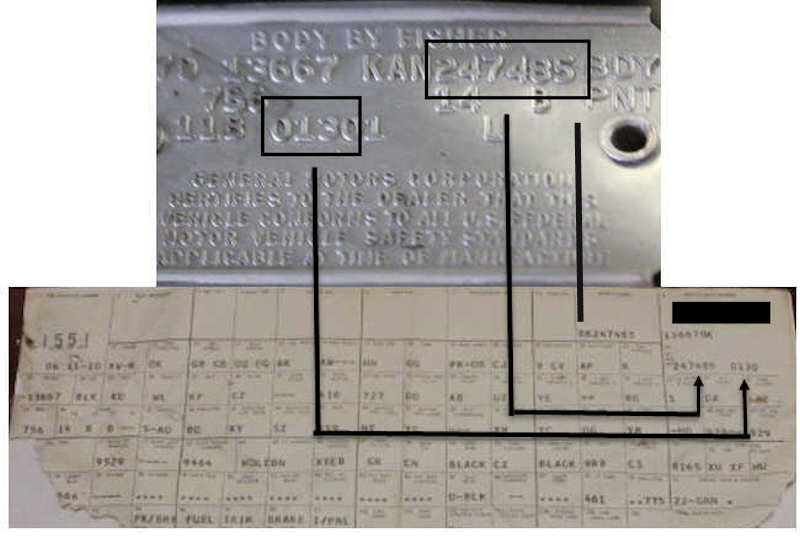
Here is another example from the Atlanta assembly plant. Even though the sequence number is present (134xxx), compare the trim tag information with the associated blocks on the build sheet. Block #27 again shows the engine broadcast code of RR which is the broadcast code for a 454/450 with TH400 transmission so this car was ordered with the SS454 (RPO Z15) option.
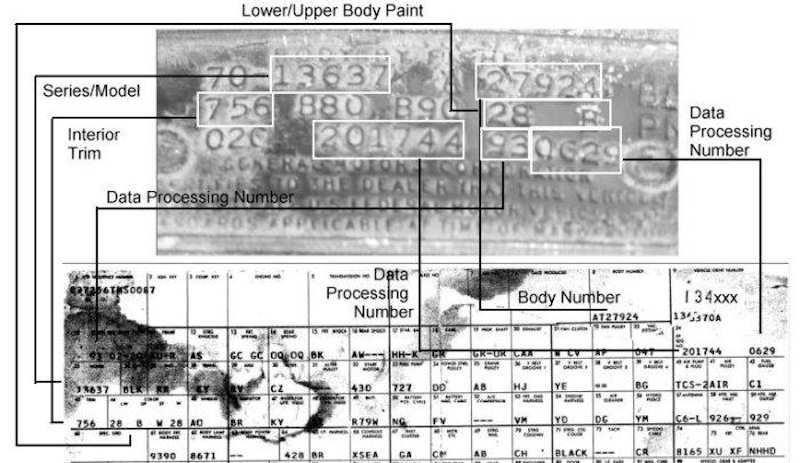
Other plants have similar numbers on the build sheet that will match those on the trim tag and will vary.
Say you saw it here on © ChevelleWorld
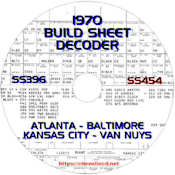
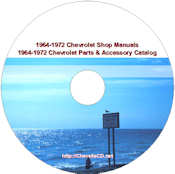

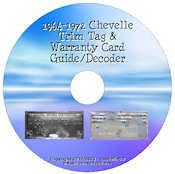
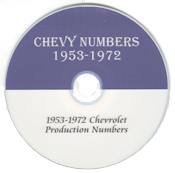
Want more in-depth information on 1964-1972 Chevelles? My 1970 SS 396/SS454
Build Sheet Decode Program CD, Shop Manuals & Parts Catalog program DVD, Facts and SS
Guide program CD, 1964-1972 Trim Tag and Protect-O-Plate program CD,
and my Chevy Numbers program CD. Check
them and other informative program CDs at my
https://chevellecd.net website.

 1964 Chevelle
1964 Chevelle 1965 Chevelle
1965 Chevelle 1966 Chevelle
1966 Chevelle 1967 Chevelle
1967 Chevelle 1968 Chevelle
1968 Chevelle 1969 Chevelle
1969 Chevelle 1970 Chevelle
1970 Chevelle 1971 Chevelle
1971 Chevelle 1972 Chevelle
1972 Chevelle








